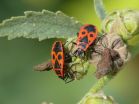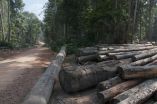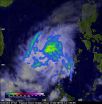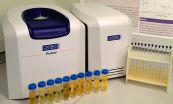Scientists identify most ancient pinworm yet found
Infested mammals' ancestors; possibly dinosaurs
2014-12-01
(Press-News.org) An egg much smaller than a common grain of sand and found in a tiny piece of fossilized dung has helped scientists identify a pinworm that lived 240 million years ago.
It is believed to be the most ancient pinworm yet found in the fossil record.
The discovery confirms that herbivorous cynodonts -- the ancestors of mammals -- were infected with the parasitic nematodes. It also makes it even more likely that herbivorous dinosaurs carried pinworms.
Scott Gardner, a parasitologist and director of the Harold W. Manter Laboratory of Parasitology at the University of Nebraska-Lincoln, was among an international group of scientists who published the study in the journal Parasites & Vectors.
"This discovery represents a first for our team and I think it opens the door to finding additional parasites in other species of fossil organisms," he said.
The team found the pinworm egg in a coprolite -- fossilized feces -- collected in 2007 at an excavation site in Rio Grande do Sul state in southern Brazil.
The coprolite was collected at a site with abundant fossilized remains of cynodonts. Previously, an Ascarid-like egg -- resembling a species of nematode commonly found in modern-day mammals -- was found in the coprolite.
The pinworm egg, representing an undescribed or "new species," was named Paleoxyuris cockburni, in honor of Aidan Cockburn, founder of the Paleopathology Association.
The structure of the pinworm egg placed it in a biological group of parasites that occur in animals that ingest large amounts of plant material. Its presence helped scientists deduce which cynodont species, of several found at the collection site, most likely deposited the coprolite.
Since the field of paleoparasitology, or the study of ancient parasites, emerged in the early 20th century, scientists have identified parasites of both plants and animals that date back as far as 500 million years ago.
The study of parasites in ancient animals can help determine the age of fossilized organisms and help establish dates of origin and diversification for association between host species and parasites. Coprolites are a key part of the study, enabling a better understanding of the ecological relationships between hosts and parasites.
INFORMATION:
Other members of the team were Jean-Pierre Hugot of the National Museum of Natural History in Paris; Victor Borba, Juliana Dutra, Luiz Fernando Ferreira and Adauto Araujo of Oswaldo Cruz Foundation in Rio de Janeiro; Prisiclla Araujo and Daniela Leles of Fluminense Federal University in Rio de Janeiro; and Atila August Stock Da-Rosa of the Federal University of Santa Maria in Rio Grande do Sul.
Writer: Leslie Reed, University Communications
[Attachments] See images for this press release:
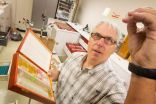
ELSE PRESS RELEASES FROM THIS DATE:
2014-12-01
This news release is available in German.
Microbial partners are important for the nutrition of many insects. They help detoxify and digest food, but also provide essential nutrients that insects need in order to survive. The European firebug Pyrrhocoris apterus and the African cotton stainer Dysdercus fasciatus feed mainly on plant seeds that are poor sources of essential B vitamins. Scientists of the Max Planck Research Group Insect Symbiosis at the Max Planck Institute for Chemical Ecology in Jena, Germany, together with colleagues at the Friedrich Schiller University, ...
2014-12-01
This news release is available in German. The neocortex is the part of the brain that enables us to speak, dream, or think. The underlying mechanism that led to the expansion of this brain region during evolution, however, is not yet understood. A research team headed by Wieland Huttner, director at the Max Planck Institute of Molecular Cell Biology and Genetics, now reports an important finding that paves the way for further research on brain evolution: The researchers analyzed the gyrencephaly index, indicating the degree of cortical folding, of 100 mammalian brains ...
2014-12-01
When it comes to logging, it may be possible to have our timber and our tropical forests, too. The key, according to a report in the Cell Press journal Current Biology on December 1, is careful planning and the use of reduced-impact logging (RIL) practices that avoid unnecessary damage to the surrounding forest.
"Four million square kilometres of tropical forest are designated for logging globally," says Jake Bicknell of the University of Kent in the United Kingdom, noting that this represents an area larger than the size of India. "Even if we could improve timber harvesting ...
2014-12-01
Researchers have identified the cause for a disorder common in Inuit people that prevents the absorption of sucrose, causing gastrointestinal distress and failure to thrive in infants. The study, published in CMAJ (Canadian Medical Association Journal), identified a genetic mutation responsible for the disorder, called congenital sucrose-isomaltase deficiency (CSID).
CSID is a rare disorder in people of European descent, but is more common in Inuit people living in northern Canada, Greenland and Alaska, with rates estimated between 5% and 10%. The disorder prevents the ...
2014-12-01
In recent years, cilia, microscopic, tentacle-like extensions from biological cells, have risen from relative obscurity and are now considered important to the understanding of many human afflictions. In a December BioScience article, George B. Witman, of the University of Massachusetts Medical School, and Jason M. Brown, of Salem State University, describe recent discoveries involving cilia-related diseases (called "ciliopathies") and highlight "model" species that could be useful for systematic study of ciliopathies.
Cilia perform a broad range of functions, including ...
2014-12-01
Tropical Storm Sinlaku made landfall in east-central Vietnam bringing some moderate to heavy rainfall with it. NASA and the Japan Aerospace Exploration Agency's TRMM and GPM satellites analyzed the rainfall rates occurring in Sinlaku before it made landfall while NASA's Terra satellite spotted the storm as it came ashore in Vietnam.
Tropical Storm Sinlaku formed on November 26, 2014 over the southeastern Philippines. As a tropical depression Sinlaku caused flooding in areas of the Visayas and Mindanao. The storm then moved west and crossed the South China Sea where it ...
2014-12-01
Scientists at the Institute of Food Research on the Norwich Research Park have teamed up with Oxford Instruments to develop a fast, cheap alternative to DNA testing as a means of distinguishing horse meat from beef. Because horses and cattle have different digestive systems, the fat components of the two meats have different fatty acid compositions, as the team report in the journal 'Food Chemistry'. The new method looks at differences in the chemical composition of the fat in the meats, using similar technology to a hospital MRI scanner.
In just ten minutes, a technician ...
2014-12-01
December 1, 2014 - The health departments of the nation's largest cities play a central role in developing innovative population health strategies for improving public health across the United States, according to a special January issue of the Journal of Public Health Management and Practice. The journal is published by Lippincott Williams & Wilkins, a part of Wolters Kluwer Health.
"Indeed, cities are at the forefront in extending public health and social policy to realize changes in our environment abetting population health," according to a commentary by Lloyd F. ...
2014-12-01
ROSEMONT, Ill.--Prompt and appropriate treatment of a dislocated shoulder--when the head of the upper arm bone (humerus) is completely knocked out of the shoulder socket (glenoid)--can minimize risk for future dislocations as well as the effects of related bone, muscle and nerve injuries, according to a literature review appearing in the December issue of the Journal of the American Academy of Orthopaedic Surgeons (JAAOS).
The shoulder has the greatest range of motion of any joint in the human body and is the most common site for a full or partial dislocation. Shoulder ...
2014-12-01
This news release is available in German. Ideally, diamonds consist of pure carbon. But natural diamonds always contain defects. The most researched defects are nitrogen-vacancy centers comprising a nitrogen atom and a vacancy. These might serve as highly sensitive sensors or as register components for quantum computers. However, until now it has not been possible to extract the optically stored information electronically.
A team headed by Professor Alexander Holleitner, physicist at the TU München and Frank Koppens, physics professor at the Institut de Ciencies ...
LAST 30 PRESS RELEASES:
[Press-News.org] Scientists identify most ancient pinworm yet found
Infested mammals' ancestors; possibly dinosaurs

